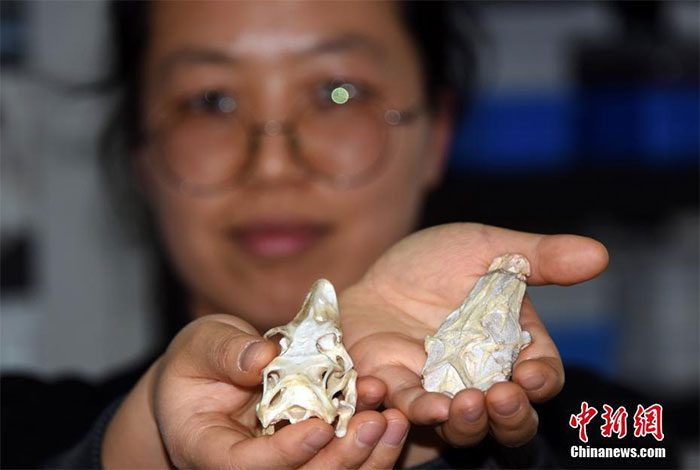A recent discovery concerning an ancient lizard species has captured significant attention from the global scientific community, published by a research team from China.
This discovery is based on the fossil research of a new genus of their “Li Giant Lizard” found in Hubei, China, dating back approximately 56-52 million years. The team believes that the “Li Giant Lizard” adds to the chain of evidence supporting the Asian origin theory of lizards.

Fossil specimen of the Li lizard.
This announcement is also detailed in a paper published in the latest issue of the international academic journal The Royal Society, authored by Dong LiPing, Wang YuanQing, Zhao Qi, and Wang Yuan – all researchers at the Institute of Vertebrate Paleontology and Paleoanthropology of the Chinese Academy of Sciences, along with their partners in the UK and Switzerland.
In an interview with the Xinhua News Agency on the same day, author Dong LiPing stated that the genus of giant lizards currently includes more than 80 species distributed across Asia, Africa, and Oceania. Giant lizards vary greatly in size and morphology: from the Dampier Peninsula species, which is two to three centimeters long in Western Australia, to the largest living lizard today, the Komodo dragon, which can reach three meters, or even the extinct giant lizard species in Australia that measured up to five meters. Some of these lizards are excellent climbers, while others are adept swimmers, and their diets are quite diverse. They can consume insects, frogs, bird eggs, large and small mammals, and even crabs and berries. Among the currently living species, the Borneo lizard (found on Borneo Island in Malaysia) is believed to be the closest relative to the giant lizard, exhibiting a reclusive lifestyle that adds to the mystery surrounding the giant lizard genus.

Ms. Dong LiPing presenting the fossil specimen of the Li giant lizard.
She pointed out that the giant lizard family originated from ancient lizards distributed across Eurasia during the Late Cretaceous period (approximately 100 million to 66 million years ago), such as in the Gobi Desert in inland Asia, which has produced many well-preserved giant lizard fossils. However, the origins of giant lizards remain highly debated, with various hypotheses suggesting their origins from Asia, Africa, or the southern supercontinent of Gondwana.
Since accurate fossil records of the giant lizard genus currently date back to the early Neogene period (about 20 million years ago), the Paleogene period (approximately 66 million to 23 million years ago) is considered a stage of evolution for ancient lizards. However, the fossil materials of Paleogene giant lizards are primarily found in scattered vertebrae, with only one well-preserved specimen being the skeleton of Saniwa ensidens. Nonetheless, this specimen is located in North America, where no giant lizard species are currently distributed, complicating the understanding of the origins of giant lizards.
In 2008, a field research team led by researcher Wang YuanQing from the Institute of Vertebrate Paleontology of the Chinese Academy of Sciences discovered a fossilized lizard skeleton in the strata of the Liguanqiao Basin (historically known as Shunyang) in Hubei Province. After meticulous restoration, utilizing high-precision machinery and conducting CT scans, along with systematic comparative studies, it was believed to represent a new genus of the ancient giant lizard family. It was named “Li Giant Lizard” based on its relationship with ancient lizards and in honor of the late Professor Li ChuanKui, a renowned paleontologist, acknowledging his significant contributions to scientific research in the Liguanqiao Basin.
Ms. Dong LiPing mentioned that the Li Giant Lizard measures about 1 meter in length, making it a medium-sized species among giant lizards. It possesses many typical features of ancient lizards, including external nostrils, an elongated snout, forward-projecting teeth in the eye sockets, rod-like limb bones, flexible interlocking jaw joints, and pronounced cartilaginous contractions in the vertebrae. At the same time, there are also clear differences between the Li Giant Lizard and ancient giant lizards, such as the unclosed olfactory tube beneath the frontal bone, the closing of the posterior orbital margin by the postorbital and squamosal bones, two rows of small teeth on the palate, and fewer openings on the shoulder blade, among others.

Comparison of the skull of the Li lizard fossil (right) and the skull of the current giant lizard.
The most remarkable feature of the Li Giant Lizard is that its forelimbs and hindlimbs (near the middle, excluding the hands and feet) are of similar length, differing from all other giant lizard species. In ancient lizards, the hindlimbs are significantly longer than the forelimbs. The near-equal length of forelimbs and hindlimbs is also rare among all scaly species, suggesting that the Li Giant Lizard may have had unique locomotion, at least different from that of contemporary Saniwa lizards. Bone histological analysis indicates that the histological features of the Li Giant Lizard are similar to those of tuatara – a type of ancient lizard.
This indicates that in this study, based on morphological comparisons and phylogenetic analysis, the collaborative research team also explored the evolution of certain features related to feeding functions in ancient giant lizards: from the postorbital margin, the closure of the frontal bone, the opening of the olfactory tube…
Previous functional studies on Nile lizards and lizards in Taiga forests with similar body sizes and ecological habits have indicated that the openness of the postorbital margin and the openness of the olfactory tube could be two complementary features in mechanical function.
During the evolution of giant lizards, the opening of the postorbital margin improved the feeding efficiency of the skull, and the closure of the olfactory tube beneath the frontal bone compensated for the increased stress due to the opening of the postorbital margin. The disappearance of teeth suggests that the tongue of giant lizards has evolved from auxiliary movement in swallowing food in the oral cavity to sensing chemical components in the air. However, the fossils of species like the Li lizard indicate that this evolutionary process may be more complex.





















































